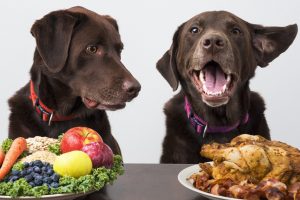How To Help Your Dog Lose Weight

As dog owners, we can all get caught up in loving, caring, and nurturing our four-legged friends who sometimes overlook their health. One area in particular that often is taken for granted is their weight.
You might be fooled by your canine tail wagging profusely and their salivating mouth, thinking they’re ecstatic. While no doubt dogs can be happy eating food, but they could be much happier if their weight does not restrict them.
Just like us humans, canine obesity can dramatically increase the risk of your dog developing illness and diseases and weight related injuries.
Do you know what the common problem is from overfeeding?
It’s thyroid issues! The most popular problem dogs have difficulty in their thyroid gland if fed too much. In particular, it can inhibit their metabolism and more. That’s just one risk you can get from the result of overfeeding your dog; there’s lots more out there.
Therefore getting your dog on a proper regimen and food timeline will help them stay at their leanest and healthiest.

How many times a day should a dog eat?
One of the most important parts of a consistent routine is feeding your dog regular meals. This will help your dog feel full and more satisfied for longer, without having to binge eat additional food. However, one common question many dog owners have is how often should dogs eat?
Well, according to the American Kennel Club, they should eat a minimum of two meals a day to start off with. But equally as important as the amount, if not more, is the portion size of their meals. To know exactly how much to feed your dog, the first step should be visiting your vet. A vet will take their measurements and weight and then review what their ideal weight should be.
Then from there, they will provide you with advice on how much to feed your dog each day and the type of food that is best for them. A vet will also help identify where the weight is stored, what’s causing the weight gain, and how you can help your dog shed a few pounds.
If your dog has excess weight, it’s up to you as their owner to put the effort in to get them into peak shape. It’s not easy at first, but with patience and consistency, it is doable. To help you with this, here are some top tips on how to help your dog lose weight and stay in good health.
We also advise before you make such changes consult your veterinarian first.
6 ways to help your dog lose weight
MEASURE YOUR DOG’S FOOD
Measure all the food you give your dog, and try to reduce the total by 1/4. This allows you to keep track of what they’re eating when they’re eating, and how much of it is adding to their weight.
KEEP YOUR DOG AWAY FROM THE TABLE
Keep your dog away from the table. Avoiding food scraps and leftovers is ideal in reducing your dog’s weight. You may think your dinner is a healthy treat, but it adds more fat or additional food to the total you’re already giving them. Here are the 10 most toxic foods to dogs to watch out for.
CONSIDER LOW-CALORIE ALTERNATIVES
Consider lower-calorie treats, healthier supplements, and natural replacements to what you’re used to giving your dog. Fruit and vegetable treats are a great alternative to high-calorie meat-based treats. Just make sure the ingredients are not going to harm your pet.
STAY CONSISTENT
Make sure everyone in the family is on the same page with your pup’s new diet. Much like people, it takes time and consistency for diets to work for dogs.
MONITOR PROGRESS
Monitor their progress by going for weekly weigh-ins. You want to make sure all your efforts impact your dog’s life in a healthy way. Weigh-in day should be an exciting experience for everyone involved!
MAINTAIN THE IDEAL WEIGHT
- This isn’t a temporary solution. Maintaining the diet and keeping your dog on a healthy meal plan should be a permanent improvement in their life. This is for their health and their benefit. So, don’t let them down!
Exercise
Exercise is also very important in your pup’s weight loss journey. It’s enjoyable and simple for them to do exercise. All you need to do is take them walking, running or swimming. If you want to do this, it’s always best to begin slowly and gradually increase the exercise over increments.
How long does it take for a dog to lose weight?
Many dog owners often ask their vet how long it can take to start noticing results in seeing their dog lose weight. This answer is based on the type of exercise they’re doing, the frequency of activity and their diet.
It’s believed that dogs can safely shed 2-4 percent of their weight each week till they reach a healthy weight. When your dog is dieting, you should ideally get your dog’s weight checked by the vet or do it yourself every few weeks.
Final thoughts
Overall to help your dog lose weight, you should measure their portions, offer low-calorie alternatives, keep consistent, monitor their progress and more. If you find that none of this is working, your dog might be suffering from something beyond just a weight problem. Let your vet know your progress and steps, and see if they should investigate further.

FAQS
Is it cruel to feed a dog once a day?
Ideally, it would help if you didn’t feed your dog one meal a day unless told to by a vet. On average, your dog should have at least 2 meals a day, 12 hours apart. But most dog owners provide their dogs with breakfast, lunch and dinner.
Does walking a dog help lose weight?
Walking your dog is a great activity to do each day with your dog; it provides physical and mental stimulation. However, if your dog needs to lose weight, they should be taken out on more strenuous exercise so this could mean longer walks, more walks, running, swimming or additional playtime.
How soon after eating do dogs poop?
For your dog to digest its food properly, it could take around 8-12 hours. However, certain breeds have fast metabolisms, only taking up to 4 hours to digest. If your dog is a puppy, expect them to poop 5-30 minutes after they’ve eaten.
Why do dogs act like they are starving?
Your dog could be acting like they’re hungry as a sign of not having enough energy. Dogs tend to do this because their cells try to convince them they need more sugar. It could be a sign of underlying disease such as hypothyroidism, making them more hungry. It’s always best to get checked with a vet first.
How do I know if I’m feeding my dog enough?
You will know if you’re feeding your dog enough if they’re at the correct weight according to your vet and eating their meals. On the contrary, if you can see your dog’s rib, spine and it has no body fat, this could be a sign of malnourishment. Moreover, if they have runny feces, they could not be eating enough. In these moments, it’s important to check with the vet if they’re healthy.
Do dogs ever get full?
There’s a range of skepticism surrounding dogs’ appetites. It’s believed that dogs don’t know when to stop eating even when they’re full.
However, usually, it depends on the dog breed, how they behave and gain weight. Some dogs stop eating from their bowls, others like to free feed, and others gain weight from the slightest bit of food. Ultimately, it’s important as a dog owner for you to know when to stop feeding your canine.
Also Check Out: Tips To Help Your Dog Lose Weight
